|
Lesson 4
Niels E. Hansen and Doane Robinson
|
| |
Land west of the Missouri River was now open for homesteading.
Agriculture was not easy there. Grasshoppers sometimes ate crops as fast as they
grew. Dry summers, cold winters, and high winds made farming hard.
New plants and ways of farming needed to be found.
|
|
|
|
Niels E. Hansen and Cossack Alfalfa
|
|
Niels E. Hansen was a plant scientist. He adapted plants so they
would grow in South Dakota. He was born in Denmark in 1866. He and
his family were immigrants. He came to America when he was seven
years old. He went to school at Iowa State College. Then he got a
job at South Dakota State University in Brookings.
|

Photo courtesy of South Dakota State
Historical Society
|
|

Alfalfa
|
Beginning in
1897, Hansen went to Europe and Russia.
He looked for "hardy" plants from "hardy"
climates. He thought these might do well in South Dakota. His most
important find was Cossack alfalfa. This plant can survive
harsh cold and dry weather. From the
steppes of Siberia,
Hansen brought back one teaspoonful of seed. Alfalfa soon became an
important crop in western South Dakota. Hansen also brought smooth
brome grass and crested wheat grass to the state.
|
|
|
In all, Hansen found three hundred plants
that would grow here. They were fruits, flowers, trees, and
forage crops. He won many awards for his work. He
died in Brookings in 1950.
|
|
|
|
Doane Robinson and South Dakota History
|
|

Photo courtesy of South Dakota State
Historical Society
|
The 1890s were busy years. South Dakota became a state. Government
was set up. Officials were elected. Laws were made. Railroads began
to connect the state to the rest of the nation (read about this in
Unit 6). South Dakota now had a past and a future to think about.
Doane Robinson believed in South Dakota. He wanted to learn the
history of its peoples. He wanted to save that history for people
who would live here in the future. He was born in Wisconsin in 1856.
His parents named him Jonah, but his baby sister called him "Donah."
This became Doane. He moved to Dakota Territory to practice law. But
other things were more important to Robinson than law.
|
He wrote poetry and fiction. He gave talks about the history of
South Dakota. He started a magazine. It was called the Monthly
South Dakotan. It was about the history and culture of the
state. Soon Robinson helped to start the South Dakota State
Historical Society. He became a
historian for the state.
He collected items important to our history. He talked to Indians
and non-Indians who lived here in the early days. He put the things
they told him into magazines and books. He started a state museum
and library. There he kept safe the things he collected. Today, we
can still see and study these things from our past. They are in the Cultural
Heritage Center in Pierre.

Photo courtesy of South Dakota State Historical Society
Robinson had many good ideas. Mount Rushmore in the Black
Hills was one of his ideas. He worked for good roads and
tourism.
He died in 1945 in Pierre.
|
| Vocabulary |
|
| agriculture (n.), the
raising of crops or livestock; farming
forage (n.), food for animals like sheep or cattle
historian (n.), a person who studies the past
|
steppes (n.), treeless plains; grasslands
tourism (n.), traveling for fun
|
|
|